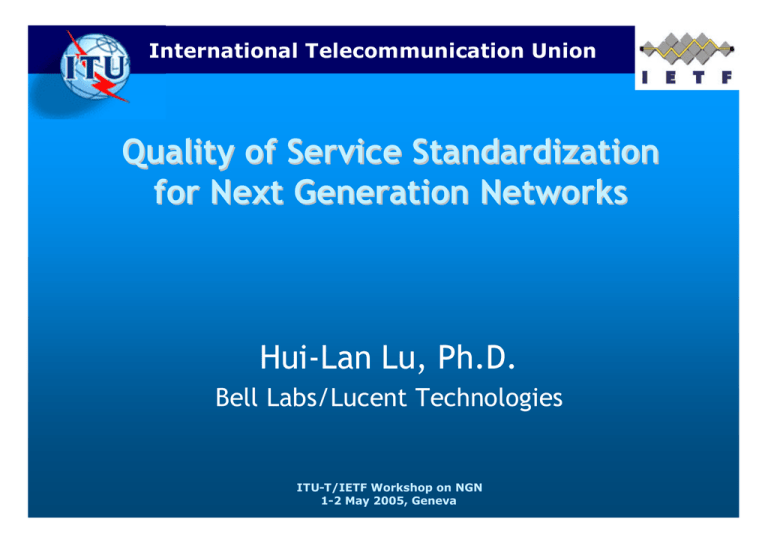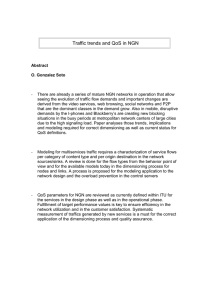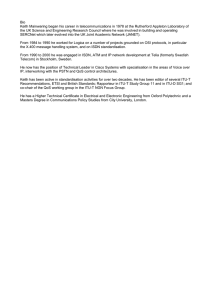Quality of Service Standardization for Next Generation Networks Hui-Lan Lu, Ph.D.
advertisement

International Telecommunication Union Quality of Service Standardization for Next Generation Networks Hui-Lan Lu, Ph.D. Bell Labs/Lucent Technologies ITU-T/IETF Workshop on NGN 1-2 May 2005, Geneva Outline ITU-T o QoS and NGN o Key standardization areas o Current FGNGN view on • Performance objectives and QoS classes • IP QoS signaling • Resource and admission control • Inter-domain performance measurement and management o Summary ITU- T/IETF Workshop on NGN, 1-2 May 2005, Geneva 2 QoS and NGN ITU-T E.800 QoS: the collective effect of service performance which determines the degree of satisfaction of a user of the service CUSTOMER PROVIDER 802.xx Access Cable NGN Core QoS Needs objectives reality QoS Achieved DSL (Cf. G.1000) QoS Perceived QoS Offered NGN Core 2G/3G Wireless Next generation network are Ø Packet based (IP, MPLS …) Ø Without inbuilt QoS Ø Multi service Ø… o Customer perceived QoS is end to end, related to reliability and security o QoS in NGN presents complex issues, including correlation with charging o NGN QoS standards should allow for incremental deployment ITU- T/IETF Workshop on NGN, 1-2 May 2005, Geneva 3 Key NGN QoS Standardization Areas in ITU-T ITU-T 1. Performance objectives and classes a. b. 2. SG 12 SG 16 Dynamic QoS controls, including a. b. c. d. e. 3. 4. Application performance Network performance Signaling of performance requirements Dynamic activation of QoS controls Inter-provider QoS Interworking of QoS mechanisms Framework and guidelines Performance measurement and monitoring Performance assessment SG 12 SG 11 SG 13 FGNGN SG 4 SG 13 FGNGN A major goal is to define a standard toolkit for providing session QoS end to end independent of access technology ITU- T/IETF Workshop on NGN, 1-2 May 2005, Geneva 4 FGNGN QoS Deliverables Title ITU-T Area Latest Draft Target Date Status Dec ‘04 A Signalling requirements for IP QoS (TRQ.IPQoS.sig.cs1) 2.a Q Series Supplement 51 A QoS control architecture for Ethernetbased IP access networks (TR-123.qos) 2.b FGNGN-OD-00106 March ‘05 A Multi Service Provider NNI for IP QoS (TRmsnniqos) 2.c FGNGN-OD-00107 3Q ’05 D General aspects of QoS and network performance in NGN (TR-NGN.QoS) 1 FGNGN-OD-00129 3Q ’05 D Network perf. of non-homogeneous networks in NGN (TR-NGN.NHNperf) 1.b FGNGN-OD-00130 3Q ’05 D 3 FGNGN-OD-00126 3Q ’05 D 2.b-e FGNGN-OD-00128 3Q ’05 D A QoS Framework for IP-based access networks (TR-ipaqos) 1, 2 FGNGN-OD-00113 4Q ’05 D Requirements and framework for end-toend QoS in NGN (TR-e2eqos.1) 1, 2 FGNGN-OD-00127 4Q ‘05 D A QoS architecture for Ethernet networks (TR-enet) 2.b, 2.d FGNGN-OD-00131 4Q ’05 D Algorithms for Achieving End-to-End Performance Objectives (TR-apo) 1.b, 2.a FGNGN-OD-00135 4Q ‘05 D Performance measurement and management for NGN (TR-pmm) Resource and admission control functions (TR-RACF) ITU- T/IETF Workshop on NGN, 1-2 May 2005, Geneva 5 Adopt Y.1541 IP QoS Classes/Network Performance Objectives in NGN ITU-T Terminal-to-Terminal QoS (Y.1541) Terminal Network QoS Control Transport o Encompass key IP application categories o Are relatable to practical IP network o o o o QoS mechanisms Are verifiable at network boundaries Are readily applicable to NGN Are being enhanced in ITU-T SG 12 Are being incorporated into IETF NSIS Qos signaling Network QoS Terminal Network QoS Control Control Transport Transport Network Performance Parameter Nature of Network Performance Objective Class 3 Class 0 VoIP Class 1 VoIP Class 2 signaling Interactiv e data Class 5 (Unstreaming specified) Class 4 IPTD Upper bound on the mean IPTD 100 ms 400 ms 100 ms 400 ms 1s U IPDV Upper bound -3 on the 1-10 quantile of IPTD minus the minimum IPTD 50 ms 50 ms U U U U IPLR Upper bound on the packet loss probability 1*10 IPER Upper bound -3 1*10 ITU- T/IETF Workshop on NGN, 1-2 May 2005, Geneva -3 1*10 -3 -4 1*10 1*10 -3 1*10 -3 U U 6 Agree on IP QoS Signalling Requirements Q Series Supplement 51 Protocol Requirem ents ITU-T S R C U N I T E D S T IP Network Cloud N N I G W G W G W G W U N I N N I . . . G W G W L A N T E L A N Network Customer Installation Network Network End-End Network (IP Service QoS ) Customer Installation User-to-User Connection (Transport and higher Q o S) T E Terminal Equipment G W Gateway Router Protocol Stack * N I Network Interface o Attributes of a QoS request o Contention resolution for resource allocation - Y.1541, network capacity, reliability/priority o Flow control for QoS (re-)requests, congestion aware o Support for request-offer-answer exchanges - Expected performance, QoS parameter negotiation o Parameters and values for transport connections - IP 5 tuple, IP DSCP o Expressive of accumulated performance - Forwarded request containing achieved values, or - Each network communicating its contribution o Support for release of resources o Support for symmetric information transfer capability o Error reporting o Emergency service supported through reliability/priority o Performance requirements for QoS requests - Signalling transport supporting Y.1541 QoS Class 2 - Average delay < 800 ms - Max delay < 1500 ms o Minimal number of messages for a QoS transaction o Recovery from failures at TE, network entities o Forward and backward compatibility ITU- T/IETF Workshop on NGN, 1-2 May 2005, Geneva 7 Converging Resource and Admission Control for Access and Core Networks ITU-T Application ASF AGWF Session & Call Control SCF SCPF MGCF MRCF PDF ? Policy Server UMTS/CDMA Ethernet Cable Transport Adaptation CMTS GGSN PDSN/HA HLR AAA SGSN UTRAN Router AAA WLAN GW CDMA RAN Cable Cable Access Access Modem … Bandwidth Manager DSL BRAS DSLAM DSL/ATM DSL/ATM Access Access Modem WiFi Access Points o o Build on Unified the IETF resource policy-based control framework andadmission admission in support of (RFC 2753) and IMS “bearer” control to support session QoS end to end fixed mobile convergence is desirable Include transport resource control for NAPTs and firewalls ITU- T/IETF Workshop on NGN, 1-2 May 2005, Geneva 8 Filling Gaps in Inter-Domain Performance Measurement and Management • o Unspecified options, parameters ITU-T Specify how attributes are measured o Concatenation of performance over — multiple network segments o Accuracy o Data handling — • — — Define attributes to be measured — Mean delay, delay variation, packet loss, unavailability • — Proposed default rollup period one hour Active probes tailored to service classes (telephony, multimedia streaming, low latency data) Default probe transmission period 1 sec. Clock synchronization to Coordinated Universal Time through GPS Algorithms for computing performance Specify the inter-PRS interface Service Provider A Performance Reporting System Collection Platforms Summary reports, measurement requests Control, Reports Control, Reports Config, Reports, Policing info Config, Reports, Policing info Probes, Policing info PE/CE Service Provider B Delay/Loss Probes Edge to edge, Site to site, or TE to TE ITU- T/IETF Workshop on NGN, 1-2 May 2005, Geneva Probes, Policing info Performance Reporting System Collection Platforms Measurement Platforms PE/CE 9 Summary/Next Steps o ITU-T o o o o Multiple drafts under development address various QoS issues with different levels of maturity • Continuing rationalization • Synergistic cooperation with relevant standards development organizations Y.1541 QoS classes/performance objectives and Y.1221 traffic descriptors have been adopted for use in NGN • Interworking and harmonization with other QoS classification schemes • Apportionment of performance values across networks Approved IP QoS signaling requirements provides a basis for developing needed protocols • Making use of existing or emerging standard protocols? • In-band versus out-of-band signaling • Path-coupled versus path-decoupled signaling A consistent approach to resource and admission control in access, core and at interconnects is emerging • Checking against requirements and alignment with the overall architecture • Completion of information flows and interface requirements • Selection or development of the protocols for the interfaces A standard approach for inter-domain performance measurement and management is emerging • Agreement on the specifics of active probes and protocols for discovery of and performance data exchange between performance reporting systems • Tuning of parameter values and alignment with Y.1541 ITU- T/IETF Workshop on NGN, 1-2 May 2005, Geneva 10


